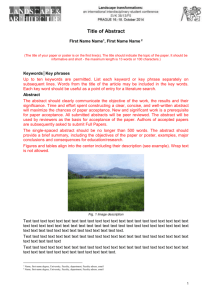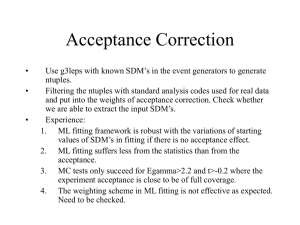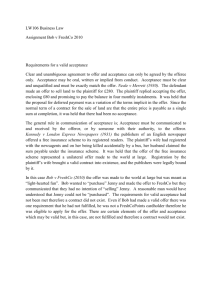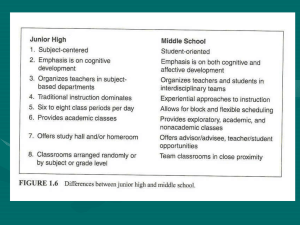Information Systems Innovation among Organizations
advertisement
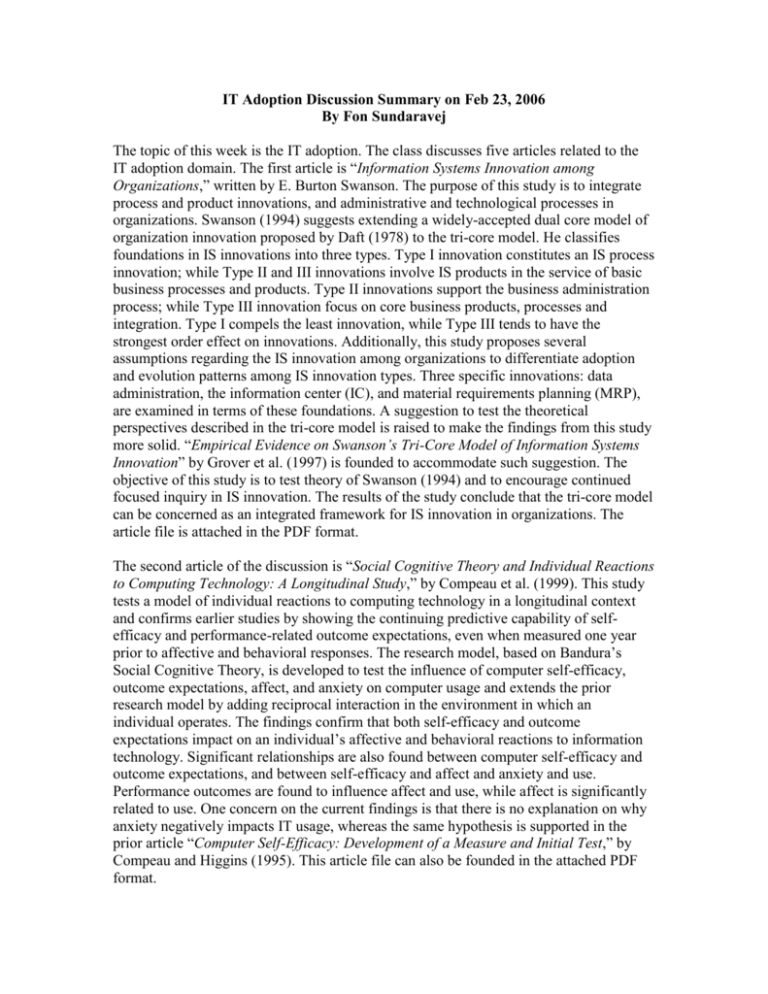
IT Adoption Discussion Summary on Feb 23, 2006 By Fon Sundaravej The topic of this week is the IT adoption. The class discusses five articles related to the IT adoption domain. The first article is “Information Systems Innovation among Organizations,” written by E. Burton Swanson. The purpose of this study is to integrate process and product innovations, and administrative and technological processes in organizations. Swanson (1994) suggests extending a widely-accepted dual core model of organization innovation proposed by Daft (1978) to the tri-core model. He classifies foundations in IS innovations into three types. Type I innovation constitutes an IS process innovation; while Type II and III innovations involve IS products in the service of basic business processes and products. Type II innovations support the business administration process; while Type III innovation focus on core business products, processes and integration. Type I compels the least innovation, while Type III tends to have the strongest order effect on innovations. Additionally, this study proposes several assumptions regarding the IS innovation among organizations to differentiate adoption and evolution patterns among IS innovation types. Three specific innovations: data administration, the information center (IC), and material requirements planning (MRP), are examined in terms of these foundations. A suggestion to test the theoretical perspectives described in the tri-core model is raised to make the findings from this study more solid. “Empirical Evidence on Swanson’s Tri-Core Model of Information Systems Innovation” by Grover et al. (1997) is founded to accommodate such suggestion. The objective of this study is to test theory of Swanson (1994) and to encourage continued focused inquiry in IS innovation. The results of the study conclude that the tri-core model can be concerned as an integrated framework for IS innovation in organizations. The article file is attached in the PDF format. The second article of the discussion is “Social Cognitive Theory and Individual Reactions to Computing Technology: A Longitudinal Study,” by Compeau et al. (1999). This study tests a model of individual reactions to computing technology in a longitudinal context and confirms earlier studies by showing the continuing predictive capability of selfefficacy and performance-related outcome expectations, even when measured one year prior to affective and behavioral responses. The research model, based on Bandura’s Social Cognitive Theory, is developed to test the influence of computer self-efficacy, outcome expectations, affect, and anxiety on computer usage and extends the prior research model by adding reciprocal interaction in the environment in which an individual operates. The findings confirm that both self-efficacy and outcome expectations impact on an individual’s affective and behavioral reactions to information technology. Significant relationships are also found between computer self-efficacy and outcome expectations, and between self-efficacy and affect and anxiety and use. Performance outcomes are found to influence affect and use, while affect is significantly related to use. One concern on the current findings is that there is no explanation on why anxiety negatively impacts IT usage, whereas the same hypothesis is supported in the prior article “Computer Self-Efficacy: Development of a Measure and Initial Test,” by Compeau and Higgins (1995). This article file can also be founded in the attached PDF format. The third article is “A Theoretical Integration of User Satisfaction and Technology Acceptance,” by Wixom and Todd (2005). Prior research relating to the technology acceptance falls into two streams: the user satisfaction or technology acceptance. User satisfaction is proved by many researchers to be a weaker predictor of system usage, compared to technology acceptance to usage. The purpose of this study is to reconcile these two approaches and develop an integrated research model that distinguishes beliefs and attitudes about the system from beliefs and attitudes about using the system to better understand the influence on IT usage. The study is conducted across organizations on their use of data warehousing software. The proposed model is supported to prove that the two perspectives can be integrated. However, the system and information satisfaction and quality do not serve as direct antecedents to intention in the similar fashion as usefulness and attitude. The influence of these factors should be fully mediated through usefulness and ease of use. Moreover, system characteristics such as completeness, accuracy, format, currency, reliability, flexibility, integration, accessibility, and timeliness, are proved to be weak predictors of intention, unlike usefulness and attitude, as suggested by former studies. A weakness of this article may fall into the low level of distinction between constructs affecting to either information quality or system quality. Compared to other articles studied this week, the objective of this article is not to better predict the IT usage intention. Rather, Wixom and Todd (2005) try to find a method to explain the usefulness and attitude indication on the intention. The fourth article is “A Comprehensive Conceptualization of Post-Adoptive Behaviors Associated with Information Technology Enabled Work Systems,” by Jasperson et al. (2005). This study proposes a comprehensive research model aimed at combining existing research on post-adoptive IT use behaviors and at directing future research on those factors that influence users to continuously exploit and extend the functionality built into IT applications. Jasperson et al. (2005) conceptualizes the post-adoptive behavior construct, provides a combination of the factors in previous research, and locates definitions for these factors to facilitate future research in this domain. Three aspects of post-adoptive behavior that have been under-researched are prior use, habit, and a feature-centric view of technology. Applying such notions, the post-adoptive behavior involves two levels of analysis: individual’s cognitions and behaviors and organizational context within which these individual cognitions are situated. The conceptualization of the research model also involves the influences of technology sensemaking, use history, and an individual’s attention to introduced interventions. Implications for research theory, research methodology, and practice are presented, based on the findings. It should be recognized that the model of this study represents a particular innovation in an organization rather than many innovations across organizations at a time. This theoretical article is difficult to be empirically validated because the sample collection is time-consuming and needs a great effort of participants’ cooperation. The last article of this week is “User Acceptance of Information Technology: Toward a Unified View,” by Venkatesh et al. (2003). Venkatesh et al. (2003) proposes and testes a unified information technology acceptance and use research model, called the Unified Theory of Acceptance and Use of Technology (UTAUT). The model integrates significant elements across eight prominent user acceptance models and formulates a unique measure with core determinants of user behavioral intention and usage. Venkatesh et al. (2003) develops and validates a new research model with seven constructs: performance expectancy, effort expectancy, attitude toward using technology, social influence, facilitating conditions, self-efficacy, and anxiety, which are hypothesized to be fundamental determinants of the user behavioral intention of information technology. The eight original models and theories of individual acceptance include the Theory of Reasoned Action (TRA), Technology Acceptance Model (TAM), Motivational Model (MM), Theory of Planned Behavior (TPB), Model Combining the Technology Acceptance Model and Theory of Planned Behavior (C-TAM-TPB), Model of PC Utilization (MPCU), Innovation Diffusion Theory (IDT), and Social Cognitive Theory (SCT). For references, articles with these classic theories/models are attached in the PDF format. Longitudinal field studies were conducted across heterogeneous contexts. The moderators such as experience, gender, age, and voluntariness are also accounted for the research model. The greatest contribution of this article is to combine core constructs in the IT innovation and adoption domain into a single model and also to confirm the history of empirical research in this area. However, further investigation on the model measurement is encouraged to ensure its reliability and validity. In summary, the diffusion of innovation theory had been prevailed in other disciplines for a long period of time. However, the evolution of IS research in the area of IT adoption has become rich in the last two decade ago. IS researchers in this domain have dedicated tremendous efforts to shape the scope of the study by introducing a new framework applied from theories in other disciplines (Compeau et al., 1999) and/or extend prior models from previous studies (Swanson, 1994; Venkatesh et al., 2003; Wixom and Todd, 2005; Jasperson et al., 2005).




